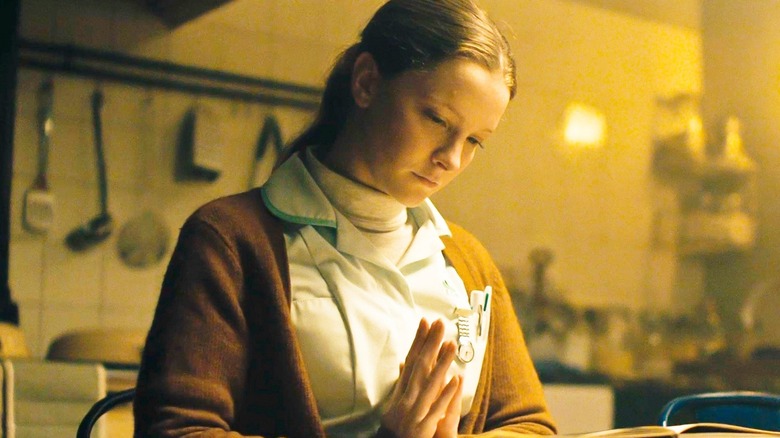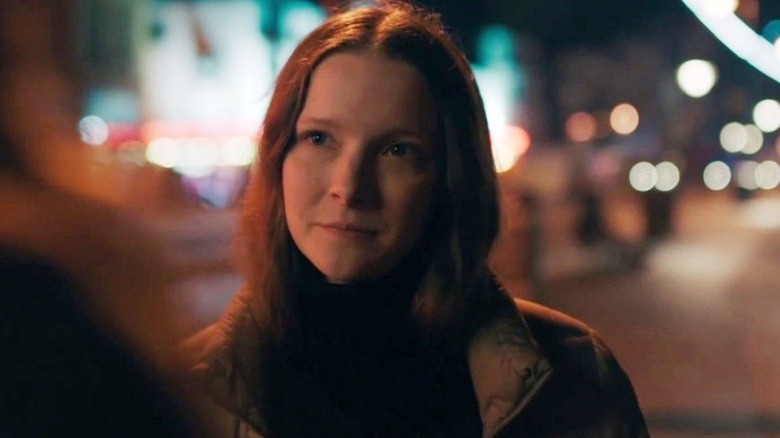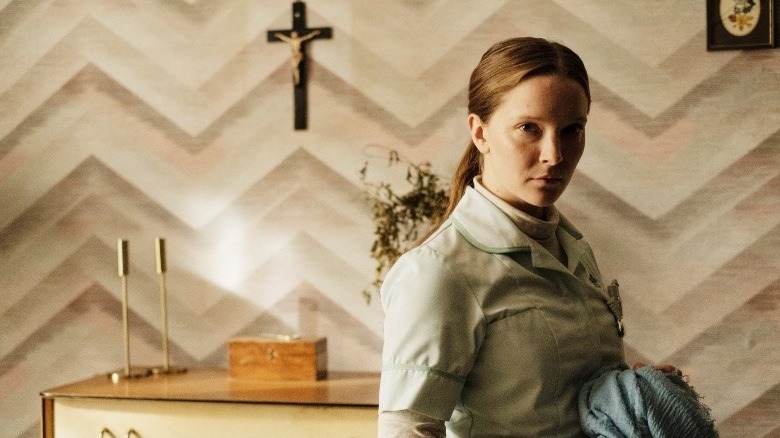The Haunting True Story At The Heart Of Saint Maud

Rose Glass' "Saint Maud" is more that just a stellar feature directorial debut for the filmmaker; it's a brutal psychological horror movie that eloquently speaks to issues of faith, mental health, and death (physical and spiritual) through a story about a young woman who may or may not be communicating with God. By pulling audiences into the head space of its lonely, traumatized lead character, "Saint Maud" leaves you wondering how much of what you're seeing is real and how much is not, right up until the film's disturbing final reveal.
The movie's horrific yet illuminating last shot makes for an effective juxtaposition to its first scene: a flashback shrouded in mystery. "Saint Maud" opens with Maud (Morfydd Clark), back when she was a nurse going by Katie, sitting in the corner of a dark hospital room, her face and hands splattered in blood as she stares in shock and disbelief at a dead body (one still dripping blood) on a nearby bed. Who was this patient to Maud? And what was she like before this happened? Wisely, "Saint Maud" never fully answers these questions, lest it over-simplify the effect this terrible event had on its protagonist.
Glass has confirmed that she intentionally played up the mystery of Maud's history, telling Vulture, "I didn't want it to be a case of it seeming like, 'This one terrible thing happened, and now it equals a crazy person.'" It's an artistic choice that feels all the more responsible, given its real-world inspiration.
The REAL Saint Maud

After its terse prologue, "Saint Maud" reveals Katie/Maud is now a pious Roman Catholic serving as a private nurse for Amanda Köhl (Jennifer Ehle), a queer dancer and choreographer dying from stage four lymphoma. But as Maud comes to believe that God wants her to save Amanda's soul, it leads her down a path of self-harm and suffering, culminating in another flashback that exposes the ghastly truth: the patient from the film's opening was an old man who Maud was performing CPR on when she accidentally opened a wound on his chest, crushing his organs and splattering her in blood.
This scenario wasn't something Glass cooked up in her imagination, as she explained to Vulture. It originated with a story "a friend of a friend, a nurse" told her about a time she performed CPR on an old man who went into cardiac arrest after undergoing "a major operation on his chest," only for the incision on his torso to suddenly break open, causing her hands to go into his upper body and squash his organs. Glass assured the nurse gave her permission to include these details in the film and enjoyed "Saint Maud," adding, "What we show is probably much tamer than how it must have actually looked. Medical stuff, in real life, is pretty f***ing intense."
What Saint Maud Means In The Covid Era

"Saint Maud" is a rare film in the way it not only acknowledges that medical professionals can experience post-traumatic stress from their jobs but subtly calls attention to the lack of social support in place for them. Combined with its examination of the effects of isolation on people's psychological well-being, this has made the movie all the more unexpectedly relevant and timely in the Covid era. Glass acknowledged as much during an interview with Screen Daily:
"... I feel like we're just sort of piggybacking on [Covid]. It's so unpredictable how it all happened. And it's more than the isolation thing. It's also the fact that it's about a carer who has had a difficult and traumatic time in her past, in her profession. The person who is taking care of someone in the film is really the person who is most in need of being taken care of. If it makes people think about that, then great. But it is a very weird fluke of timing."
Had Glass made "Saint Maud" post-Covid, it's possible she would've placed an even greater emphasis on the movie's underlying message about the need for better support systems for those working in the healthcare field. But even without that, the film provides a vital reminder: those who make their living caring for others are people too and have the same basic needs (mental, physical, and emotional) as their patients.
Read this next: The Entire Conjuring Universe Timeline Explained
The post The Haunting True Story at the Heart of Saint Maud appeared first on /Film.
from /Film https://ift.tt/3EoLTfx
No comments: